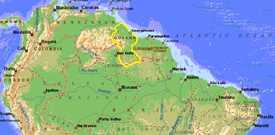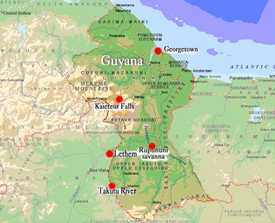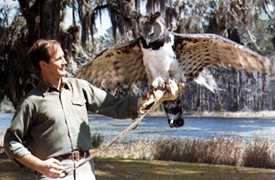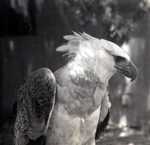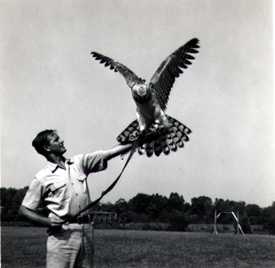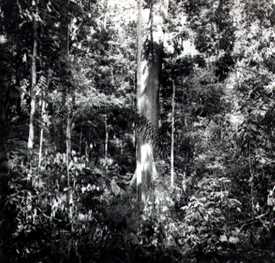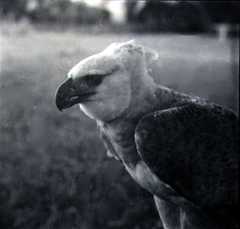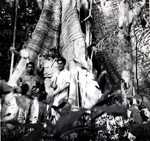Quest for the Nest
by Jim Fowler
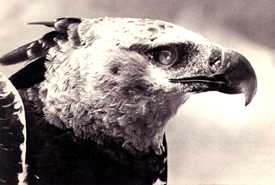 |
This is going back a little ways... to 1959.
Bolstered by a few successes I'd had on expeditions in Central and South Africa, I decided I'd try to study and, if possible, capture a young Harpy eagle. If I succeeded, I'd bring it back to the United States and use it on lecture tours. But first of all, I spent some time with my dear friend and mentor, Jim Cope, Director of the Joseph Moore Museum and Professor of Ornithology at Earlham College (my alma mater) in Richmond, Indiana. Jim was very enthusiastic about my project and said he'd probably join me - wherever it was that I ended up - so he could do some research on other birds in the area.
To discover where that might be, Jim advised that I travel to Chicago so I could pick the brain of the head of the Ornitholgy Department at the Natural History Museum. (At that time, generally known as The Field Museum.) It was good advice. Everyone at "The Field" was very supportive and dug up all sorts of information that might help me. It was there that I learned that no other scientist had ever described the nest of the Harpy eagle. Not one! Well, that was certainly an added incentive for my trip. After many days of discussion and study, I concluded that maybe British Guiana (now officially known as the Co-operative Republic of Guyana) was the best place to begin my search for the Harpy. It was an English-speaking country. There was a museum in Georgetown, its capitol. I could gain access to the interior from Georgetown - yes, that was where I'd go.
I started preparing for the trip in earnest.
|
|
Just after Christmas...
...I flew down to Georgetown in
an old, beat-up DC-4. It was a fascinating place. Exactly what you'd
picture a lazy seaport town to look like - with a lush landscape, old
colonial buildings awash in pastel colors and a huge marketplace with an
unbelievable abundance of foodstuffs on display. Meats, poultry, fish of
every kind hanging on huge hooks. Baskets and barrels of grains, beans,
rice and manioc lining stall after stall. Fruits, vegetables - I'd never
seen such a variety of produce before. And the smells....
But it
was the variety of people that impressed me the most. Georgetown was a
veritable melting pot of nationalities. Chinese, Africans, Portuguese,
English, Russians, Americans - you name it. People of every color, every
background. The country at that time was known as "The Land of Six
People." I'd say it was more like sixty.
Closed for the
holidays
It was Christmastime so the government offices were
closed and I couldn't do any official business - but I did begin asking
people that I met if they knew anything about Harpy eagles. (You never
know who knows something that will help you.) I met with Ram Singh,
the curator of the Georgetown Museum, several Europeans and Americans and
quite a few missionaries who had contact with some of the aboriginal
tribespeople in the interior. Wai Wai tribespeople, for example, who lived
in villages just north of the Amazon river. A people whose only contacts
with foreigners were missionaries. And I asked the missionaries if they
would please radio-contact their compatriots in the interior and let the
tribespeople know of my interest in finding a Harpy eagle's nest.
I
did have to worry about what the missionaries told the
tribespeople, however. I asked them to word their communiques very
carefully because I had learned a hard lesson in Africa and I didn't want
anything like that happening in South America. In Africa I'd found that if
you asked people about hawks, for example, and they sensed that hawks were
valuable to you, they'd go out, climb a tree, break the legs of a hawk,
remove it from its nest, bring it to you and say here it is. So I knew I
had to be pretty careful.
Unfortunately, I wasn't careful
enough. The missionaries sent the message and I was confident that
there wouldn't be any misunderstanding, but I was wrong. Just before I was
about to leave for the interior, word came back that tribespeople had
actually found a Harpy nest in southern Guyana, near the Brazilian border.
(In the Kanaku mountain range located in the Rupununi savannas.) My heart
was pumping. Here I'd come all the way from North America to one of the
thickest rainforests of the world and was about to see the nest of an
animal that not even the researchers of the Georgetown Museum had ever
seen!
But the hammer fell.... The Indians had found my Harpy nest,
all right, but instead of leaving it alone and waiting until I arrived on
the scene, they cut down the tree that the nest was in, decided the nest
was too large to fit into a plane and disassembled it. What awaited me was
a heaping pile of twigs and branches. Come on down, the weather's
fine!
I learned my lesson the hard way that time - really the hard
way. My first Harpy eagle's nest - absolutely destroyed! Fortunately I
heard that there weren't any young ones in the nest, so I didn't have the
blood of young chicks on my hands. (I would have carried that one on my
conscience for a long time.) I was able to corroborate this much later on
when I finally got to that area. I saw that the young must have fledged
before the tree was felled because they had adapted to another
nest.
So, you see, I thought I had learned a lesson that I'd never
repeat. No such luck. A short time after the Harpy expedition - on an
anaconda expedition, in fact - I was again reminded of my carelessness. It
happened this way.... Soon after I'd gotten the word out that I was
interested in filming anacondas, I got one, all right - delivered to me
right in my lap. Some tribesmen had not only trapped one for me, but
lugged it for miles and miles through the rainforest and proudly presented
it to me in my camp! It never entered their minds that I had wanted to
film the anaconda in its natural habitat!
Anyway, you sometimes get
in trouble like that even when you should know better.
The
expeditionary force
Three of us started out on the search for a
Harpy nest. Ram Singh, the Georgetown Museum curator, Ivan Viyash - a
longtime resident of Guyana who hired on as cook - and myself. Now Ivan
was the real "character" in this trio. Educated in the British school
system, he spoke the "King's English" and enjoyed telling stories about
the different kinds of jobs he'd had over the years. There were many jobs,
so he had many stories to tell. The most interesting were about his work
as a drugger. Now, "drugger" isn't what you think it is. During the 1930s
and 1940s - druggers were people who sold goods - necessities of all kinds
- to the gold and diamond miners camped out along the trails in the
mountains of Guyana and Brazil. Druggers like Ivan actually lugged those
goods on their backs for hundreds of miles!
Anyway... I hired a
plane that would ultimately take us to Lethem, a little outpost in the
Rupununi savanna in the southern part of Guyana. But first we just had
to take a little detour. You see, I'd heard about the Kaieteur
waterfall in the Pakaraima mountains - a tremendous waterfall in the
middle of the jungle that very few people had ever seen. How could I pass
up that opportunity, right? And it turned out that Kaieteur was as
magnificent as I imagined it to be. Its waters falling almost 800 feet
from its escarpment. An absolutely phenomenal sight. Maybe not as
impressive as Salto Angel, ("Angel Falls") in neighboring
Venezuela, with its escarpment-to-bottom distance of 3,000 feet, but
Kaieteur sure impressed me. I'll never forget it.
|
|
We left the rainforest and flew over the Rupununi savanna. A vast open area that, like other savannas just above and below the equator, is very, very dry and burns repeatedly, year after year. A burning process that regenerates its vegetation of grass and scrub growth. There is water, however. Savannas such as Rupununi are laced with creeks. And along the edges of these creeks are what is called "Ete palm swamps." So what you see is grassland, scrub brush and then palm trees and lush grass surrounding the watercourses.
Our flight lasted several hours and in all that time there wasn't a sign of civilization. Not until we reached Lethem - that little outpost I told you about which is on the Takutu River, near the border between northern Brazil and western Guyana.
The landing...
... was quite an experience.You come in
low over the old wooden hotel and the first thing you notice is a
tremendous number of vultures hanging around. They're there because the
approach to the landing strip is right beside an abattoir where all the
cattle are slaughtered. And to make matters worse, right behind the
abatoir is a dump where the leftovers from the cattle butchering are
deposited. With vultures dodging this way and that, it isn't very
conducive to a safe landing, right? And it's even worse taking off. You
lift off the runway and scared vultures galore start letting everything
loose from their mouths - and their other ends - and it's a bit of a mess.
We saw signs of it everywhere. Especially atop the hotel roof. Enough of
that....
|
Jim finally gets his Harpy Eagle - you'll see |
Well, the first thing we did was try to get rooms in the hotel -
which, by the way, was a very disorganized place. It took a while, but we
finally got - well, it's hard to call them that - "rooms." They were
really more like stalls. Stalls in an open barn. They had partitions but
they didn't have ceilings. It had something to do with better air movement
so it would be cooler. Anyway, I can tell you this, you hear all the
noises from all the other "rooms" when you're living in the Lethem Hotel.
Eventually I went into the hotel's kitchen. Now you don't want to do that.
A dirt floor... pigs walking around... not very appetizing. The food
wasn't bad, though. This was in January
1960.
Networking
Okay, it was time to get down to
business - get the word out and gather information. Actually, picking the
best place to do my networking was a no-brainer. The bar at the Lethem
Hotel was the only bar for hundreds of miles. Sooner or later, that's
where everyone would show. So, that's where I camped out.
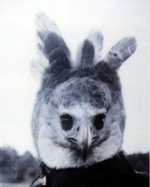 |
It was like something out of the movies - and diamond hunters, who came over from Brazil, were the biggest stars. The Lethem bar saw its share of volatile types - men who looked like they'd go ballistic if you looked at them sideways. And there were the secretive, silent, Clint Eastwood types as well. Men who sat apart. Took the measure of the crowd. Were ready for anything.
And, of course, the talkative showmen were there, too. The ones who
told stories of pain, sorrow and defeat one second, then switched gears -
put on a smile, did a little dance - and told marvelous tales of diamond
discoveries. How Joaquin, Jorge and Pedro - yes, even Pedro - onetime
dirt- poor vacaros made their way to the Takutu river where it reached the
mountains and... within a month (the storyteller snaps his fingers!) yes,
within one month these destitute vacaros became hugely wealthy. "They
threw money into the air! They threw money at the bartender! They stuffed
money into the ears of their 'friends.' And they laughed and drank - Lord
how they enjoyed themselves!"
Nice stories. And they weren't
necessarily figments of the teller's imagination. During my short stay in
Lethem I saw a few vacaros do some crazy things after they made it BIG in
the diamond fields. But none of them threw money my way.
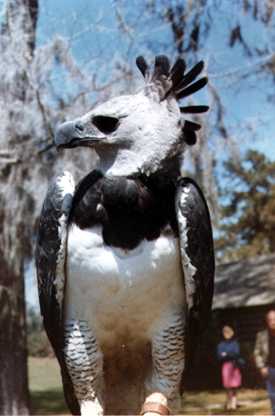 |
But here's the real problem with the Cabora fly... The female phlebotomine sand fly bites at night, carries a parasite called Leishmaniasis and transfers that parasite to the host it attacks. The host being a dog, rodent or human. Now the Leishmaniasis parasite multiplies like crazy and destroys the cells of the host. Infecting its viscera - lungs, kidneys, liver or spleen; or its skin - causing boils, ulcers and various other lesions on the face, legs and arms; or its mucosal linings (this manifestation is very common in Central and South America) invading the mucous membranes of the nose, nasal septum and mouth and resulting in severe facial lesions and extensive deformity. In the region I was in they call this last type: bush (or forest) yaws.
As you see, Leishmaniasis is a very destructive disease.
|
|
Zeroing in
Anyway, after talking with quite a few people,
I found out that there had been some Harpy eagles observed in the Kanaku
mountains. So I studied my maps and decided the best idea was to circle
around a good 60 miles south of Lethem and try to penetrate what they call
the bush mouth which is an opening between the savanna and rainforest. But
we needed some kind of transportation to get us there. And that's where a
White Russian by the name of Goretsky came in.
Some background
on Goretsky... and "Genevieve" the jeep
Not too long after the
Russian revolution, many "soldiers of fortune" - men from all over the
world - made their way to Brazil to help build its railroad system.
Goretzky was one of these men. For many months he cleared, dug and
detonated, filled and leveled the land and along the way, layed hundreds
and hundreds of miles of track in Brazil's Amazonas. Then he
quit.
When the goverment of British Guiana offered 99-year leases
on immense tracts of land in the Rupununi savanna, Goretzky couldn't
resist. He wanted to develop a cattle ranch there. Oh, he knew it wouldn't
be easy. The sparseness of grassland in the Rupununi would mean it would
take his cattle four to five years to fatten to the extent that six months
of grazing fattened a United States cow. But that didn't matter. Goretzky
had time.
When I met him, he was responsible for feeding several
families of children and had garnered two, or four (it wasn't clear how
many) Indian wives. He had many, many head of cattle, too - and wore
chaps, had pistols strapped to his waist, rode a beautiful horse and had a
motorcycle. Seemed like he was doing just fine.
It was at his ranch
that I met up with some people who had an old delapidated US Navy Jeep. It
had been abandoned after a naval operation had come into Georgetown many
years before. If I wanted to borrow it, good luck. The steering was shot.
They didn't think I could fix it. I named her Genevieve and got to work.
Somehow or other I patched her up enough to get her running.
To
the bush
By this time, Jim Cope had arrived, so the four of us
packed our gear into Genevieve and headed for Nappi Creek - a 60-mile
drive through savanna, plus six more through rainforest. The savanna part
of the trip took a while, but Genevieve held up so well that we decided to
give her a go in the rainforest, too. At the bush mouth we found a very
narrow, very muddy, bullock cart track through the rainforest. Genevieve
kept churning and churning and we kept praying and three hours later we
were at Nappi Creek. Our faithful abandoned ex-Navy jeep was probably the
first ever to reach the Nappi.
|
|
In the bush
Now the Rupununi savanna floods during the
rainy season, but the rest of the year it's pretty well bone dry. And it
was this dryness, accompanied by light breezes that many Indians preferred
over the deep forest. So we found that many tribespeople spent as much
time as possible in the Rupununi. They did have to raise their crops of
plantain and manioc, hunt and fish in the bush, however, and because of
this, there were many campsites, as well as temporary villages in the
interior.
So we set up our camp in one of these abandoned Indian
campsites. A campsite in a somewhat small clearing. Actually, it was not a
very smart thing to do. One reason? Ectoparasites. If you camp where
others have camped, you'll find lots of ectoparasites. And one of them is
the Digger flea. A very persistent insect that manages to enter your shoe,
home in on your heel, bore into the skin of your foot and lay 40,000
eggs.
And you carry those eggs around for quite awhile. Imagine,
your expedition is long over, you're back home in England, or Japan, or
Russia or wherever and you take off your socks one night and before your
eyes thousands, literally thousands of baby fleas that have been
incubating in your foot start hatching out of their egg
cases.
That's one of the nastiest things that occurs in the
rainforest. So you have to be careful moving around human habitation. It's
a good idea to start with a fresh camp.
Giant limbs come tumblin' down
There were restrictions
associated with setting up a "fresh" camp, however. British Guiana law
required that all government and/or scientific research groups doing
studies in the rainforest had to camp in areas free of trees within 200
feet of tents. That meant most groups had to cut down a great number of
trees before they could make camp.
The reason behind the tree
clearing was simple: falling limbs. You see, one of the ways nature prunes
rainforest trees is by unleashing violent storms. Their lightning,
gale-force winds and torrential rains can bring down limbs of enormous
girth because they're wrenched off of trees that are hundreds of years
old. Nature prunes so younger trees get sunlight. So they get the chance
to keep growing. It's not uncommon for a gigantic limb to break off, fall
a hundred, hundred-fifty feet and kill or maim people.
It
happened to us
Remember that abandoned Indian campsite we were
occupying? Well, the Indians we'd inherited the site from weren't bound by
British Guiana law. There were plenty of granddaddy trees smack dab in the
middle of our campsite. And one night...a big old four-foot wide limb from
one of them fell from 150 feet up! Fortunately it came crashing down on
our kitchen, not on any of us.
|
|
The next morning, Ivan confessed that he'd suspected something was going to happen. For several nights he'd been hearing the "crew, crew, crew" sound of the limb - ever so slowly splitting away from the tree. Now that made me angry. When I asked him why in the world he hadn't told us something was going on, he answered that it was a combination of his being fairly sleepy when the noises were going on and being frozen with fright.
All I knew was, if I'd known that there was a limb splitting above us I'd have taken measures. But that shows you that the most dangerous elements in the rain forest aren't jaguars, aren't snakes, aren't digger fleas - after what I saw, watch out for falling limbs!
New clearing, new start
So we changed sites. But we
didn't cut the trees all around our clearing because this time I was
careful to pick a campsite where the trees were fairly young. It was a
beautiful camp. With a streambed close by - actually an offshoot of Nappi
Creek - so there was water. And we were near a small village of maybe 15
to 20 people who were very friendly.
One of the first things I did
after we set up camp was bring out my pictures of the Harpy. There were
only two Harpy eagles in captivity at the time. The one I had worked with
at a place called John Hamlet's Birds of Prey located in Ocala, Florida
had a missing eye. The other was in our National Zoo and was crippled. I
had pictures of the one-eyed Harpy and I took it around to the villagers
and various other Indians in the area and asked if they had ever seen the
bird.
Well, amazingly enough, after a couple of weeks I met a young
man by the name of Manuel (his English name) - a member of the Macushi
tribe - who told me he had seen such a bird and heard its call. When he
imitated that call, I really got excited. It was definitely the call of
some kind of eagle. It could be an immature Harpy!
|
|
Where had he seen the bird? Just six or seven miles through the forest along Nappi Creek!
Keep cool, Jim
I tried to stay calm. Tried to be remain objective. It couldn't happen this fast. Sure I'd traveled 4,000 miles to Georgetown, Guyana, flown into the interior, dumped everybody into an old jeep that could hardly move and slushed over an almost impassable bullock cart trail... but end up in a campsite that was only seven miles from a Harpy eagle's aerie? The odds against that happening had to be very, very great! Keep cool, Jim.
But it could be. This was an almost completely undisturbed forest. Sure, there were little villages up and down the river and trails leading from one to the other - but bordering the clearings, the trails, the creek, was a forest so forebodingly thick, it's no wonder there was only one person who had seen the Harpy. How lucky I had been to find Manuel. A man who wasn't afraid to get off the beaten track. A man who was curious. Manuel - my kind of man!
I just had to get started right away. Viyash was tending to the kitchen. Ram Singh and Jim Cope were off somewhere discovering all sorts of wonderful birds indigenous to the area. "Their numbers and variety was staggering," Jim Cope had reported.
|
|
So it was just me and Manuel. Curious Manuel. We moved down the main trail and when it ended followed a smaller trail. And when the foliage thickened we hacked our way through it. Manuel had a machete. I had a Malaysian parang. One mile, two miles, three. It was slow going. It was hot. It was buggy. But we were on the trail of the Harpy eagle and my adrenalin was pumping.
